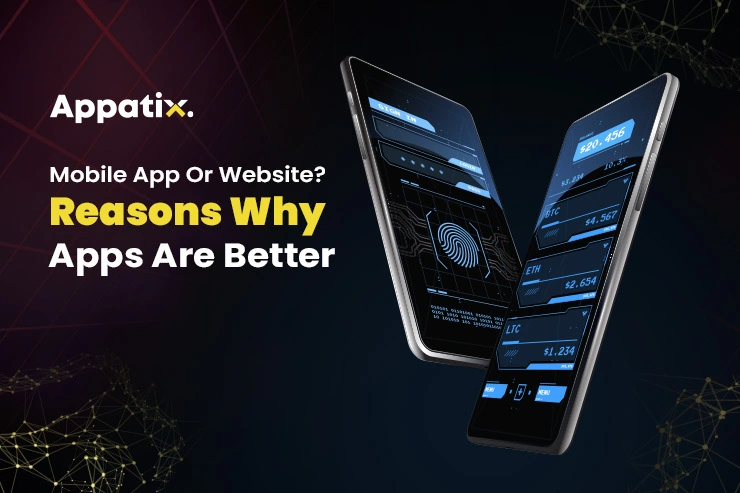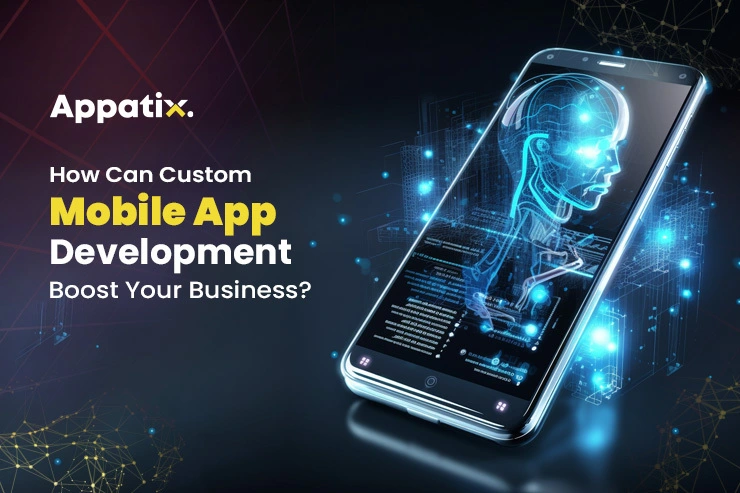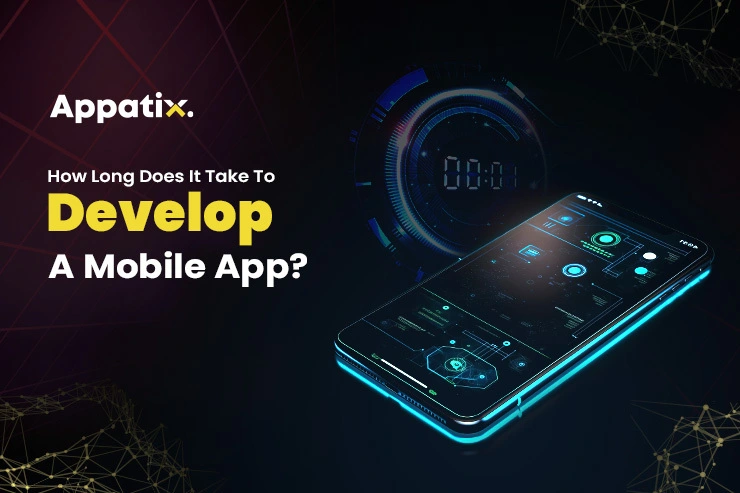
Mobile App Or Website? Reasons Why Apps Are Better
It’s a mobile era, and a huge number of the population is mobile users rather than desktop users! About 6.6...

The most common question asked is, “How long does it take to build an app?” when it comes to mobile app development, to answer this question, first, we should comprehend the app development stages and the factors influencing the concluding development timeline.
If we consider comparing apps of diverse intricacy and number of features, according to internet sources, the average timeline will be:
https://buildfire.com/what-to-expect-from-a-mobile-app-development-platform/
The image above describes the roughly estimated time an app development takes. The time differences, however, depend on several reasons, including the product complexity, the structure of the final model, the partner app Development Company, and many more.
This article will look in-depth into these features and reasons to define the mobile app development process from scratch, including timeline examples.
The time required by the mobile app development process depends on several factors, including app complexity, app idea, additional integrations, the experience of your development team, maintenance plan, UI design, app maintenance, backend infrastructure, design and functionality, and many more, according to the personalization.
The app’s complexity hugely impacts app development, the utilized technology stack, its features and functionality, the development team size, and the overall project scope. The timeframe for different kinds of apps is listed below, but it’s significant to remember that these are based on approximations and might change in actual use.
The development time a mobile app building takes ranges from 4 to 6 months and depends on the app’s complexity.
Simple app creation with restricted functionalities usually takes around 2 to 4 months, such as a utility app with individual use or an app with basic information. These apps usually don’t significantly require backend connectivity or functionalities, having simple user interfaces.
Mid-level apps’ standard time, such as social media e-commerce apps with moderate functionality or productivity, is approx. 4 to 8 months. These apps normally hold more complex user interfaces and backend integrations, including those for payment gateways and user authentication, besides involving extra features such as real-time messaging or location services.
Complex app development, such as one for a game, a marketplace, or enterprise-level software with substantial features, can take up to eight months to a year or longer. These apps normally request special features or innovative functions like AI or augmented reality, along with all-inclusive user interfaces, composite backend systems, and third-party integrations.
Creating an eye-catching and user-friendly design requires time. The timeline for UX and design can vary depending on elements like the design’s fluidity and adaptability for multiple screen sizes, the use of custom animations, the degree of interactivity, and the user testing requirements. The UX and design completion usually takes a few weeks to 2-3 months.
The duration of app development varies considerably depending on its intricacy, further involving its functionality, features, functionality, and overall scope. The more refined the apps are, the more they will need time to plan, build, test, and refine. However, simple apps can take a few weeks to develop, while more complex apps might take several months or even a year.
Setting up a server, increasing a database, and producing APIs are all fragments of a strong backend infrastructure. The involvement of the app’s integration requirements and functionality regulates how long backend development will take. It can even last 5 to 10 weeks.
Implementing the user interface (UI) and ensuring its receptiveness among all platforms and devices are significant parts of app development. The design’s complexity and the need for bespoke animations impact the front-end development’s duration. Typically, front-end development takes around 5 to 10 weeks.
Involving third-party services, APIs, or libraries in the program can considerably stretch the app development time. The time necessary for third-party integrations depends on the availability and API documentation, integration complexity, and any unanticipated concerns. It can take up to 30 days to a few weeks.
For assurance of a steady and bug-free app, detailed testing and quality assurance processes are essential. The testing process relies on numerous variables, including the app’s size, the features’ intricacy, the platform’s variety, and the devices it supports, besides the amount of detail required throughout the testing phase. Normally, the testing phase lasts between 6 to 10 weeks.
It’s important to comprehend that the timelines given here are evaluated and might alter depending on the project’s specifics, including the team’s size and familiarity, the resources’ accessibility, and other special features. To regulate more accurate estimations of the development schedule for your project idea, you might need to associate with our professionals to get a precise timeframe.
Now that the factors are discussed, let’s have a look at the key stages of the mobile app development process.
The mobile app development process involves different stages, all requiring different timeframes. From the planning process till the application launch, the whole process is inter-reliant and entails proper attendance. It clarifies that apps with different features and sizes have different app development times.
Each development stage described below answers the question, ‘How long does it take to build an app?’ Let’s dive in.
The first step in the process of creating an application is establishing ideas and research. It’s easy to get great ideas, but everyone doesn’t need to feel the same for that idea. The idea formation and research part hugely affect how much time it takes to build an app. This stage involves beginning with an app idea and then exploring it for more enhancements.
Another thing that this stage involves is the right audience targeting. In this beginning stage, the right audience is targeted for the app, and the target audience outlining helps the app boost after its launch and directs it in the right direction.
For example, Facebook has people of all ages on its platform, whereas Tinder has a majority of younger target audiences. Targeting has made these apps so effective and popular; consequently, it is recommended that proper research and targeting be done.
By the end of this stage, you should be getting these outcomes:
The next significant stage in the app creation process is the planning stage. Once you are aware of the market, it’s time to plan the app development process. The planning stage includes decisions related to the app configuration. These decisions involve making a choice among iOS and Android, cross-platform, native or hybrid, web-based app or mobile app, etc.
Once these plans are ready, it’s time to include the features. Now, the app features should be in a way that neither obscures the app nor slows it down. There are several basic features that are must-haves for an app, including a search bar, profile building, social media sharing buttons, login options, etc. These features make an app much more suitable for users.
As the app size increases, the features become more and more focused on the app type. For example, any e-commerce app will have the ‘Add to Cart’ feature. Likewise, social media apps hold the option of media sharing and numerous other features for engagement over the app.
All this planning is quite intricate and will require a month or so.
Design sprints are considered an irreplaceable five-day strategy for testing several application aspects. This process usually takes around a week to complete, providing plentiful time to do a detailed evaluation and confirm ideas from potential users’ diverse groups.
By directing design sprints, businesses gain a profound understanding of whether users value a specific feature, how they interact with it, possibly during its use, and their insights into the application’s ease of use. Such valuable feedback aids businesses in making well-versed decisions and optimizing their application to cater to user demands.
Building three chief elements is crucial during an app creation: the User Interface (UI), the front end, and the back end. The UI is accountable for the user experience and visual design, while the front end controls the logic and functionality that users communicate with. The backend, on the other hand, manages the server-side procedures and data storage.
By highlighting the development of these three elements, you can safeguard a seamless and well-organized application catering to the user’s specific demands and requirements.
Let us get deep into it to know what both engineering procedures comprise:
The whole development and designing stage takes around six weeks.
Choosing the best app development team to build an app catering to business-specific requirements has never been simple. You must look for the right team with the right skill set and experience. The best thing to do here is task outsourcing to a top-quality app development company, handling tasks skillfully and providing suitable and on-time output.
The ideal alternative for app building is to find the right development team with proven experience in the industry and direct all the requirements to them.
Another implausible benefit of choosing a ready-to-work development team is that they will provide you with the end result and manage all the application development stages themselves. Additionally, talented groups can deliver better comprehension of the developing app’s process, guiding the work process improvement and assisting you with selecting a native or a hybrid app grounded on your purposes.
Running an app requires a few tests to know if the app will work properly and seamlessly after development. If any bug detection occurs, it must be secured before the final launch.
There are several ways to test a mobile app’s performance and functioning. The quality assurance tests are run to prevent users from finding any bugs during app usage, making it more spontaneous.
Alpha and Beta testing are completed on the app to ensure the app is error-free, and after the testing, the app is launched. After the launch, the needed changes are made based on feedback collected by the users.
The time app deployment takes can be divided into two sections: submission & review. At the time of an app submission, either on the Google Play Store or on the Apple App Store, there are some rules you must follow, such as:
When it comes to application deployment, the time consumed on the app store varies. The App Store has a thorough review process that can lengthen the launch time. Contrastingly, the Play Store, organized by Google, uses algorithms for app analysis earlier, resulting in a shorter app launch time. If you’re seeking a rapid and well-organized deployment, consider the Play Store for a smooth experience.
We at Appatix have incredible strategies for mobile app testing to get the process complete within the time limit. As more individuals are moving towards the increasing usage of mobile devices, a well-crafted mobile app can enhance transparency, sales, productivity, brand recognition, and much more. Additionally, it helps businesses to stay competitive in today’s ever-evolving and fast-paced marketplace.
How useful was this post?
Click on a star to rate it!
Average rating 1.1 / 5. Vote count: 90
No votes so far! Be the first to rate this post.



Consult with us to learn how we can deliver value to your organization.